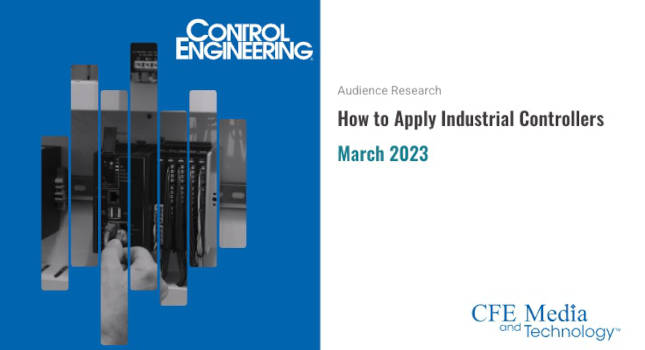5 fast facts on exclusive Control Engineering research: How to apply controllers
Five fast facts about Control Engineering research on how to apply controllers follow. See link for the report.
Five fast facts about Control Engineering research on how to apply controllers follow. Additional results will soon to be posted online at www.controleng.com/research (Responses totaled 134. Answers below allowed for more than one reply. The research, conducted in January 2023 with subscribers who specify or purchase, integrate, use, maintain or upgrade controllers for industrial applications, has a margin of error at 95% confidence, of +/-8.5% to +/-8.8%, depending on response rate for various questions.)
Click here to download the research.
- Top five controllers purchased in last six months were 73% programmable logic controllers (PLC), 61% human machine interface (HMI) hardware, 41% industrial PCs (IPCs), 32% drives for motion control and 31% programmable automation computers.
- Five areas where those industrial controllers were applied or use in last six months: 63% distributed on plant floor o r near application, 57% on machines, 34% embedded in machines, 15% virtually in a server away from the application and 13% virtually in a server locally.
- Who’s implementing the controllers is evenly split (within margin of error) between 63% end-user automation, controls or instrumentation team members and 57% system integrators. Others applying include 27% other end-user engineering or technical staff, 23% consultants, 14% other contractors and 7% other.
- Types of applications in the last six months were evenly split (within margin of error) among 57% continuous process control, 57% machine control and 54% HMI development. Others were 49% alarming, 40% monitoring, 40% supervisory control and data acquisition (SCADA), 37% programming/test applications, 37% remote monitoring, 36% diagnostics and 35% safety. (See more online.)
- How are controllers and programming being applied: Top 5 ways are 49% software tested offline, installed in controllers, which are then installed; 46% new hardware and software programming tested offline and networked to the new application; 42% new hardware and software programming tested offline and connected via local port via to a computer with the new application; 37% new hardware and software programming tested offline and brought on USB via connected computer to the new application; and 19% new software programming tested in simulated digital twin of application .
Other areas of the research, covered more in the online article and in the March issue include: Controller communications hardware and numbers of protocols needed, where controllers communicate, opinions on applying industrial controllers, cybersecurity, integration of software and hardware, upcoming purchases and if there are any vendor or controller-type restrictions.
Amanda McLeman is CFE Media and Technology research director, Mark T. Hoske is Control Engineering content manager, mhoske@cfemedia.com.
Do you have experience and expertise with the topics mentioned in this content? You should consider contributing to our CFE Media editorial team and getting the recognition you and your company deserve. Click here to start this process.


